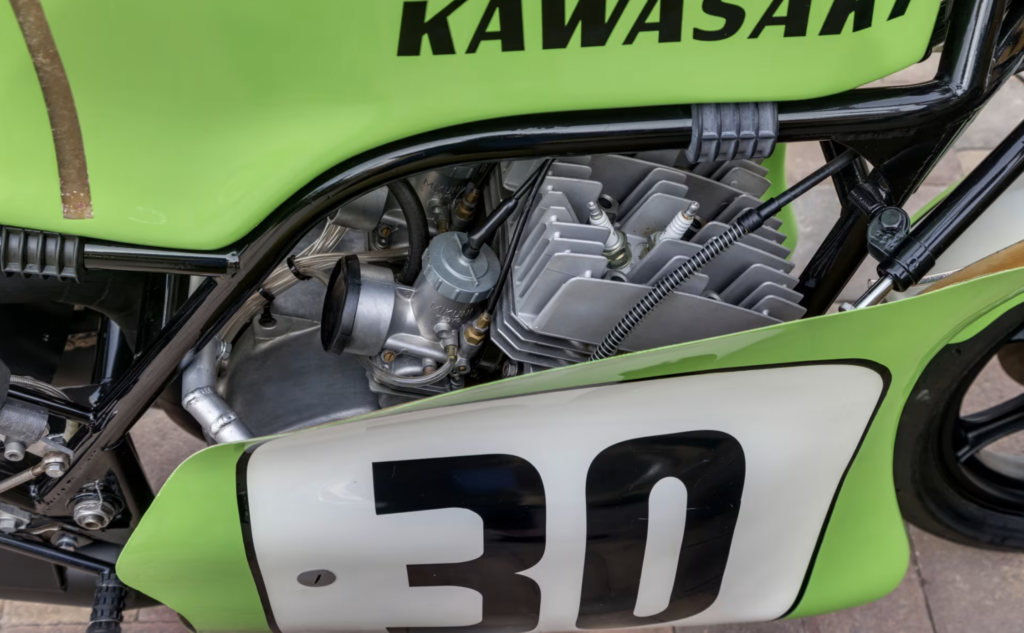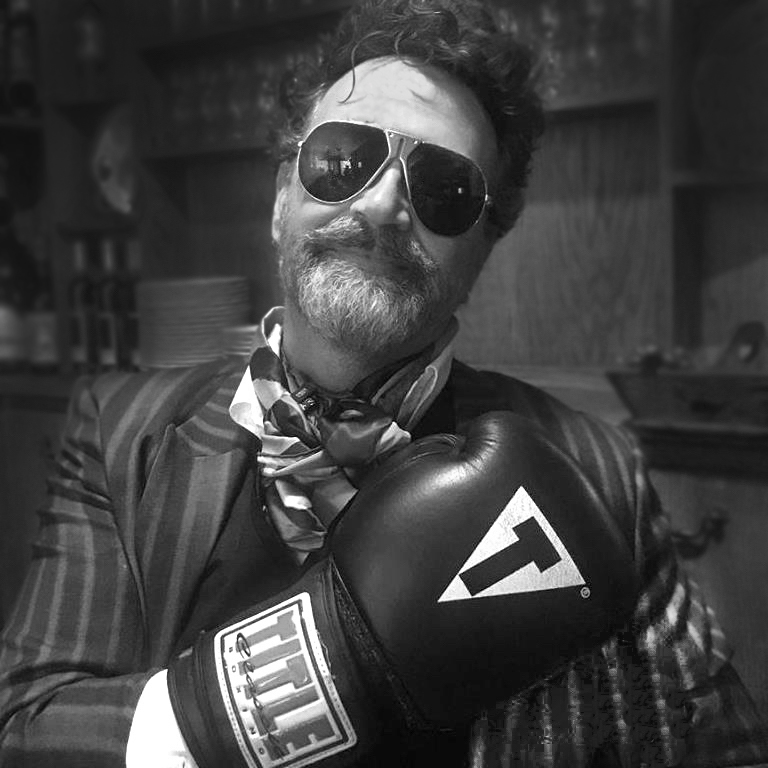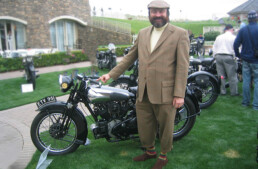Motorcycles, how do we love thee? Well, thousands of us are willing to sit in an indoor rodeo arena in Las Vegas for days, listening to the drone of a professional cattle auctioneer’s callout as hundreds of motorcycles pass under the hammer every day. 2024 is another banner year for Mecum’s Las Vegas mega-auction, with over 1400 motorcycles ready to roll across the auction podium at the South Point Hotel and Casino, with the action commencing at 9am Wed Jan 24, and running till about 4pm on Saturday Jan 27. The amazing variety of motorcycles on offer come from individual sellers, professional restorers, and this year from a record 18 special collections, ranging from John Goldman’s superb Museo Moto Italia collection to the Classic Motorcycles Austria collection to the Bud Ekins Family Trust.
The Vintagent team has selected their Mecum Top Ten for 2024 from the rabbit hole that is the entirety of Mecum’s four-day list. We invite you to have a look for yourself, and if there’s anything we missed that you think should be included, feel free to add it to the comments below, along with why it floats your boat. The following bikes float our boat, filling a variety of different neurotransmitter receptors, from funky and original, to awesomely historic, to groovy one-offs. Enjoy!
1957 F.B. Mondial 250 Bialbero


1938 Brough Superior SS100 with Sidecar







This ultra-rare, low-mileage 1953 Harley-Davidson Model KK is a one-year-only model and a factory Hot Rod. The odometer reads a believable 6,500 miles, and as a first-generation K model has a 45 CI (750cc) sidevalve V-twin motor that was revolutionary in the Harley-Davidson lineup. It was the first Harley-Davidson with both hydraulic telescopic forks and hydraulic shock rear suspension and was their first unit-construction V-twin.

The K model was Harley-Davidson’s answer to the British motorcycle invasion postwar, being significantly lighter and smaller than their Big Twin Panhead model, and intended to take over in Class C racing from the WR sidevalve model. The K model used the same bore/stroke as the old W series (2-3/4” x 3 13/16”), with a 6.5:1 compression ratio, with heavily finned aluminum cylinder heads to aid cooling. With a unit-construction crankcase, the K model saved space and weight and had a modern look, years before the British twins adopted the same idea. The standard K model Sports Twin produced 30 HP and weighed 400lbs, but the KK was a hotted-up model with a factory-installed ‘speed kit’ that included roller bearings and roller valve tappets, larger valves, ported and polished cylinders, and matching heads for better gas flow, including hot camshafts. By no coincidence, Harley-Davidson also introduced the KR model in 1953 as the factory Class C racer, and the expertise gained in tuning the new K model for racing was adapted in a slightly less fierce form to this roadster model KK: racing improves the breed, as they say.The KK Sport Twin produced 34 HP and was good for over 90 MPH, with very good handling and a modest weight making for a very sporting twin indeed.

Yamaha’s Ascot Scrambler is a fascinating machine, a combination of the YDS-2 street bike and the TD1 production racer, with its own unique bits that make parts sourcing for this bike basically impossible. Yamahas were the 250cc engine of choice for Amateur class racers, as they were limited to that engine capacity for their first year of AMA racing, and Yamaha was the fastest engine available. Tuners and racers commonly put TD1 engines into special frames by Trackmaster, Redline, et al, which put Yamaha on the podium at tracks like Ascot Park, without the factory even trying.

Yamaha had sense enough to make their own dirt racer, and the Ascot Scrambler was result: a 250cc twin-cylinder two stroke with 35hp. The Ascot, introduced in 1962, used the aluminum cylinder barrels of the TD1 with slightly smaller intakes (24mm Mikuni carbs were used), combined with expansion chambers and wheels from the TD1, and its own frame. Production lasted from 1962 to 1967, and while it was a popular seller for racers, very few survive intact, and not many are in such good original condition like this bike.

Tiny cafe racers, like kittens and puppies, provoke the same response in all motorcyclists: they SO CUTE! And this Bianchi Falco is extra super cute, and seriously badass at the same time. With its elongated gas tank looking like Alien’s motorchild, the clip-ons and humped seat, the blue metalflake paint job, and its rarity, make this Bianchi the micro etceterini cafe racer to have. It’s got a single-cylinder 50cc two-stroke motor, and isn’t a moped as it doesn’t have pedals: it’s a small motorcycle, and exquisitely designed.

I’ve seen this bike installed in the home of its owner, John Goldman, and immediately coveted it…and all the other crazy cool Italian Grand Prix racers and cafe racers in his collection. Much of that hoard is on sale in Vegas this January as the ‘Museo Moto Italia Collection’, which includes the largest private sale of F.B. Mondial motorcycles ever.
1947 Supercharged Zundapp KS600 Oskar Pillenstein racer

After WW2, Germany was banned from the Grand Prix circuit, but they still held motorcycle races, and their own German National Championship. Also, not being part of the FIM meant they could use superchargers, which were banned everywhere else. This remarkable blown Zundapp KS600 racer was originally built by Oskar Pillenstein with help from Zundapp’s head of design, Richard Kuchen. Pillenstein promptly won the 1948 German Motorcycle Championship with it, setting a class record of 103kmh.

The KS600 was the continuation of Zundapp’s prewar engine, and the basis for the legendary Green Elephant KS601 to come. Its 600cc OHV motor normally put out 28hp at 4,800rpm, but the addition of a supercharger definitely gave a power bump. There are tons of factory racing bits inside and out, as this is a unique motorcycle, and basically a factory racing Zundapp. It was restored in 1987, and was on display at a museum for almost 30 years, but is now available to you.

The first of the legendary Indian fours were basically rebadged Aces, as Indian acquired that brand in 1927, and sold them as the Indian Ace Series 401, with a 77ci (1265cc) inline 4-cylinder engine. Initially the Indian-ACE was a parts-bin special, using up remaining ACE stocks, but the Four was changed over time to become a fully Indian machine. In the first half of 1928, the engine got lighter alloy pistons, pressurized oiling, and a new cam, giving it more power and reliability, and by August of 1928, Indian had redesigned the 4-cylinder to harmonize with the rest of its model lineup. Only the first-year Indian-Ace Fours used the leading-link front fork and frame seen here, which are pure Ace items. These early Indian-Ace Fours are coveted for their rarity and unique style, and clear connection to the father of the American Four-cylinder, William Henderson.


I’ve known Ken Seavy for decades: he arranged the purchase of my Velocette Thruxton in 1989, after his boss at Good Olde Days got busted with 6 tons of amphetamines, and had to liquidate his amazing motorcycle collection. I’ve long known Ken was racing legend Art Bauman’s nephew, and that he owned Art’s old Kawasaki H2R 750, among other very rare bikes, but he never invited me to see his collection. In the 1980s and early 90s, the Kawasaki was at the nadir of its value, but Ken knew what he had. Finally, that mean green racing machine has come to light, and it’s a beauty, with a presale estimate of $180-220k.






Couple a ole standards … couple of rare nameplates …couple o’ … what the ( bleep ) is that ? .. but really … no great surprises .
Kinda like the car auctions of late … you can pretty much guess what’ll sell for what before it ever hits the auction stage …
Suffice it to say … like Leno … I only buy from owners … not online or auctions
But hey … its fun to see whats up in Auction LaLa Land
😎
Paul,
Great review. The H1R looks pretty sweet, and I have a friend interested. It varies from seller to seller, but with the H2R going through Mecum, what paperwork is promised to be supplied at the time the buyer hands over his cash? Very important and only fair to the life of the bike which will hopefully be around for many decades. I asked this question of Mecum staff (understandably busy) a few weeks ago and did not get a response.
Hi Mark, that’s the eternal problem with such a huge auction: it’s very difficult to get detailed info when you’re interested in the history of a machine. Sellers don’t seem to understand how critical documentation can be to reach the best selling price – it’s in their interest!